
An earnest film containing a mix of sympathetic monster characters, effective lighting and photography together with some ordinary production values and questionable acting performances
While on an archaeological dig in “Asia,” a group of archaeologists led by Dr Roger Bentley discovers what’s left of a five thousand year old Sumerian civilization living a subterranean existence atop a mountain in Mesopotamia.Produced by William Alland
Written by László Görög
Distributed by Universal-International
Shot in 17 days
Budget $200,000
Cast
John Agar: Dr. Roger Bentley
Cynthia Patrick: Adad (Adel)
Hugh Beaumont: Dr. Jud Bellamin
Alan Napier: Elinu, the High Priest
Nestor Paiva: Prof. Etienne Lafarge
Phil Chambers: Dr. Paul Stuart
Rodd Redwing: Nazar
Robin Hughes: First Officer
Frank Baxter: Frank Baxter
Trailer
The Hollow Earth theory

In ancient times, the concept of a subterranean realm was linked with the notion of a place of origin or with the afterlife, such as the Ancient Greek underworld or the Christian notion of Hell and portals that lead into a place of purgatory.
From Native American and Celtic mythology through to ancient Indian legends, there have been tales told of strange creatures and even ancestors emerging from a subterranean land inside the earth.




Contrary to the "Convex" hollow-Earth hypothesis by which humans live on the outside surface of a hollow planet, Cyrus Teed, a doctor from upstate New York proposed in 1869 a concave hollow Earth hypothesis which had humans living on the inside surface of a hollow spherical world, with our universe lying in that world's interior.
In more modern times there have been stories about some of Hitler's top advisors believing that the Earth was hollow (hohlweltlehre): that our surface is on the interior of a concave Earth. An expedition was supposedly sent to the Baltic island of Rugen to spy on the British fleet. Instead of training the cameras across the waters, they were pointed UP in order to observe across the atmosphere to the Atlantic Ocean! And what do you suppose was seen? Yep, nothing but sky.
Let’s not forget the stories about Hitler and many of his Nazi colleagues escaping Germany in the dying days of World War II and fleeing to Antarctica where at the South Pole they managed to locate an entrance to the Earth's interior. It has even been claimed that after the war 2,000 scientists who had gone missing from Germany and Italy along with almost a million people had wound up (in?) there as well!
It gets even more bizarre with claims about Nazi-designed UFOs and Nazi collaboration with the people who live in the centre of the Earth……
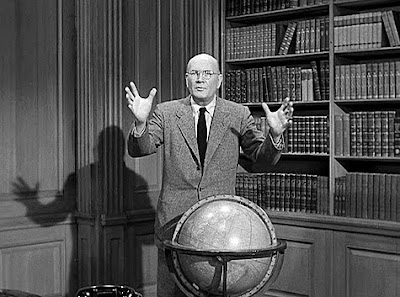

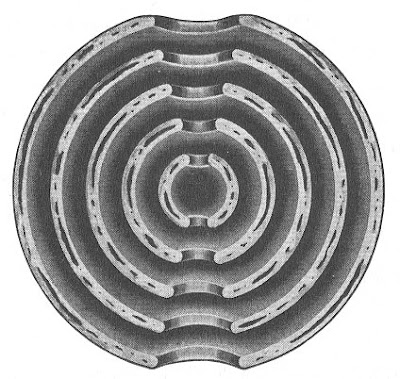
Baxter then goes on to mention John Cleves Symmes who is mentioned above. According to Baxter, in 1818 John Cleves Symmes proposed that the earth’s interior consisted of something like layers of an onion or five globes within globes which may be accessed via Siberia.


Karl Neupert, according to Baxter was actually one of several twentieth-century German writers who published works advocating the Hollow Earth hypothesis. In the 1920s the Hollow Earth Theory was quite popular in Germany. Karl Neupert, with support of the NAZI regime, wrote the book Geokosmos which helped to turn the theory into something of a cult in Germany. According to Baxter, such ideas as Neupert’s envisioned the existence within our globe of the sun, the moon and a mass of “electrical potentiality.”
So, armed with some valid historical background, our familiar and authoritative Dr Baxter informs us about the premise, nature and purpose of the film we are about to see: namely, that The Mole People is both a work of “fiction” and a “fable” which has “meaning and significance for you and me in the 20th Century.”

The opening credits follow Baxter’s presentation and seem to ascend out of a steaming hot vent from deep within the bowels of the earth to the accompaniment of a heavy and ominous-sounding music score.
“In Archaeology, all things are possible.”
The film opens somewhere in “Asia” as if Asia, instead of containing independent countries with their own civilizations, was instead some kind of amorphous, vague and exotic region which was a concept that had stubbornly remained a part of European consciousness for a long time. (A similar homogenous “clumping together” world view was held in recent history with regard to Communism and even more recently in relation to Islam!)
At an archaeological dig, Dr Roger Bentley, played by John Agar and Prof Etienne Lafarge, played by Nestor Paiva have their attention drawn to “some kind of stone tablet” which has just been uncovered.

A more ominous note is introduced concerning the tablet with the translation revealing the warning: “He who removes it with malice: May his name, his seed, his land be destroyed.” As often is the case in these kinds of films, right on cue, an earthquake strikes the area and the tablet is broken. You Have Been Warned!
"Exactly. The flood has been proven to be a historical fact, why not a Sumerian version?"
{The Sumerian version - Utnapishtim and the flood - is actually found in the Epic of Gilgamesh. Utnapishtim was tasked by Enki to abandon his worldly possessions and create a giant ship called “The Preserver of Life.” He was also required to bring his wife, family, relatives, craftsmen of his village, baby animals and grains. All animals and humans that were not on the ship would wiped out in the oncoming flood}
The party of scientists now decide to follow in the direction where the evidence seems to be pointing them: to the mountain where the artefact came from.
“The thing that impresses me most is the complete and utter silence. You can almost hear it.”

A base camp is set up and a final assault on the mountain is due to commence on the next day. As if the mountain’s spirit is angry with the humans for their intrusion, a storm blasts the base camp that evening.
As they set off on the climb up the mountain the next morning we see a fairly good low budget blending of archive film footage and actors simulating the climb. Suddenly an avalanche brings down an artefact – an arm from a statue. As the party of scientists continue climbing they stumble upon the 5,000 year old ruins of an ancient Sumerian civilization. They later happen upon the face of the goddess Ishtar.

{The film’s story tries to connect the goddess Ishtar and the Sumerians whereas Ishtar was the Babylonian counterpart of the Sumerian goddess Inanna.}
While Dr. Stuart walks around the ruins, he falls down through an opening in the ground. This is followed by an interminably long rescue attempt as the rest of the party descend on ropes to save their comrade. Notice that throughout the descent there is no music or sound effects. The sense of impending danger is implicit in this silent claustrophobic alien underworld as our protagonists make their silent descent almost echoing Ishtar’s descent to the underworld.


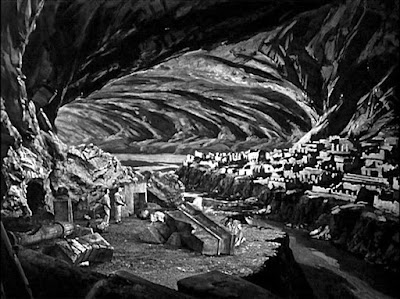
“There’s going to be history rewritten when we get out of here.”
The men then find a large tablet informing them they have discovered the temple of Ishtar. As they settle down for the night in the most uncomfortable manner possible, a bizarre looking creature emerges from the ground. Soon after, the three men are attacked, sacks are placed over their heads, and in a very unnerving process of capture they are literally pulled into and under the ground.


“Gentlemen, we are in 3000BC!”
When the men awake they discover they are in a cave and that Lafarge has nasty looking claw marks on his chest. Dr Bellamin comments, “Claw marks! Maybe a hand - -four cuts” to which Bentley responds with, “Some hand. Whoever it was needs a manicure.” (Hey guys! Lafarge is in pain and distress here!)



Not being slow on the uptake, the three men make themselves scarce by fleeing into a cave, with guards in close pursuit.
The men soon discover the eyes of the city’s inhabitants “can’t tolerate the light” being albino and adapted to a world without sunlight. When the three intruders shine their flashlight in the faces of the First Officer, the King and High Priest, all three vampire-like retreat from the light.
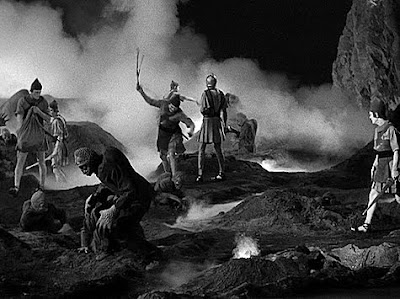
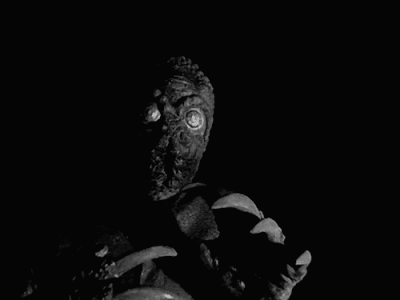
Suddenly, Laforge is attacked and killed by one of the creatures which is quickly driven off by the flashlight. The remaining two men bury Laforge right there as he was a man who devoted his life to the world of the past – a place “where he always lived.”
“The divine fire of Ishtar"
When Bentley and Bellamin return to the city they are met by the high priest who informs them that they are welcome back to the city and are now considered to be “holy messengers” who "possess the divine fire of Ishtar."


{Cynthia Patrick's character in the film is called Adel, but appears as Adad in the end credits. Interestingly enough, Adad is an Akkadian (Akkadian Empire reference to the Semitic speaking state that emerged around the city of Akkad north of Sumer) storm-god, counterpart to the Sumerian Ishkur.}
The High Priest informs the outsiders that Adel is not human but is instead a "marked one" who bares the “mark of darkness.” I’m afraid that very much like we surface-dwelling “humans,” these subterranean Sumerian survivors share human beings’ prejudicial penchant for discrimination based on something as superficial as skin pigmentation or other trivial forms of physical, cultural, ideological, linguistic or religious and gender differences!
The King and Priest go on to explain that when the population gets too large its size is maintained by sacrificing excess numbers in the fire of Ishtar. How often in our own history have we seen nations, communities, sects and crazy cults arrive at the logical conclusion of adhering to the principle of the needs of the many outweighing the needs of the few or the ends justifying the means with disastrous consequences in terms of loss of life and liberty. Strangely enough the principle often doesn’t extend to the power elites of such societies!




Bentley and Bellamin intervene when three of the creatures are being whipped and beaten, but as luck would have it their flashlight batteries begin to fail foreshadowing what is soon to follow.
The creatures are now free and are in open revolt but as a result, food production has been reduced. The subterranean death-cult’s answer to this dilemma? Let’s have another sacrifice! Yea!

A pretty cool ritual dance is performed and is followed by three women being escorted into a dazzlingly illuminated chamber where they are locked in. When the chamber is later opened, their charred remains are carried out on stretchers.
Correct me if I’m wrong but aren’t the subterranean Sumerians super-sensitive to light? After all, they had to shield their eyes from the light when the door to the chamber was opened. Then why aren’t the three women who were selected for the sacrifice similarly affected? They were able to walk into the chamber containing of the Fire of Ishtar with their eyes wide open! Well, time for more whippings and sacrifices! Let’s find those responsible for continuity or lack of it!
High time in the film now for a spanner or two to be thrown into the works: A nasty complication as arisen with the discovery of the dead body of Lafarge. Far from being a “divine messenger who has gone to heaven” or called back to Ishtar, it is apparent to the High Priest and to the king that he is merely mortal. The King agrees with the High Priest to have Bentley and Bellamin killed.
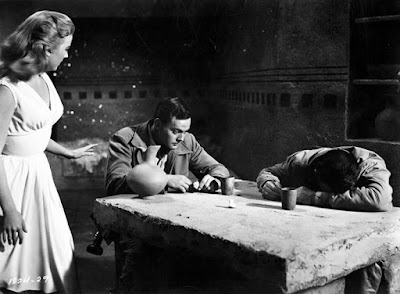

“To your people it was a burning death; To us it’s life.”



©Chris Christopoulos 2015
